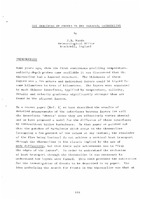| dc.contributor.author | Woods, J. D. | |
| dc.date.accessioned | 2018-10-11T14:09:25Z | |
| dc.date.available | 2018-10-11T14:09:25Z | |
| dc.date.issued | 1972/09 | |
| dc.identifier | 118 | |
| dc.identifier.govdoc | CP-7 | |
| dc.identifier.uri | http://hdl.handle.net/20.500.12489/593 | |
| dc.description.abstract | Some years ago, when the first continuous profiling temperaturesalinity- depth probes came available it was discovered that tht thermocline had a layered structure. The thickness of these layers was a few metres and individual layers could be tr<;.lced f 0 _' some kilometres to tens of kilometres. The layers were separated by much thinner interfaces, typified by temperature, salinity, density and velocity gradients significantly stronger than are found in the adjacent layers. | |
| dc.format | 9 p. : ill. ; digital, PDF file | |
| dc.language | English | |
| dc.publisher | NATO. SACLANTCEN | |
| dc.source | In: SACLANTCEN Conference Proceedings 7 (1972), pp. 144-152 | |
| dc.subject | Fronts (Oceanography) | |
| dc.subject | Ocean thermocline | |
| dc.subject | Water masses | |
| dc.title | The structure of fronts in the seasonal thermocline | |
| dc.type | Papers and Articles | |
| dc.type | Conference Proceedings (CP) | |
